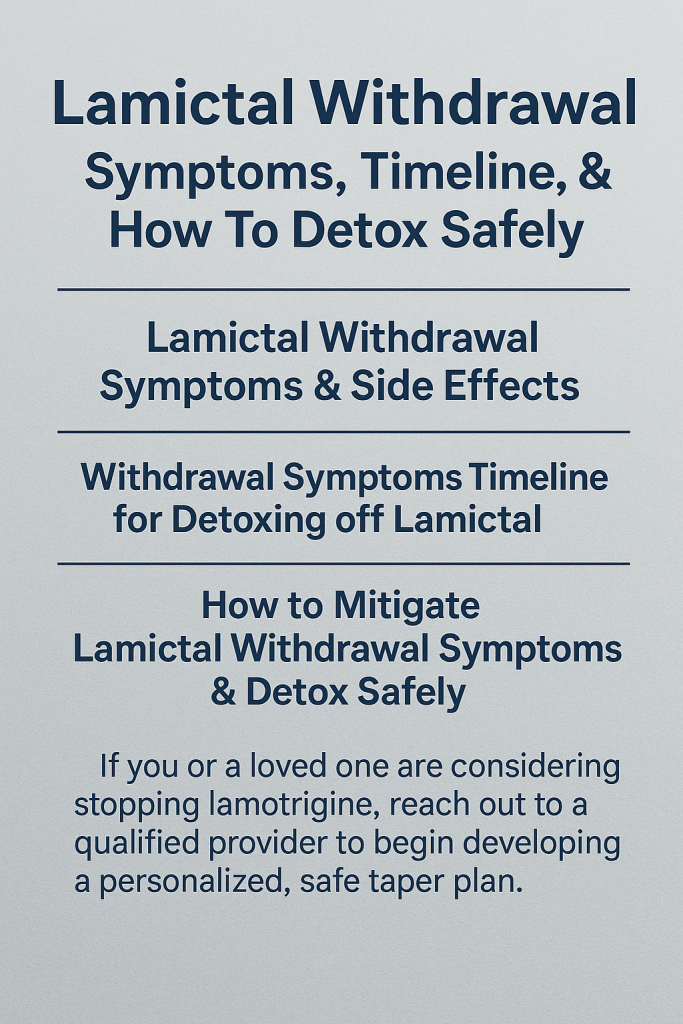Last Updated on September 18, 2025
Lamictal Withdrawal: Symptoms, Timeline, & Detox
Drug Information
Brand / names: Lamictal
Drug class: Anticonvulsants and Mood Stabilizer
About the Author
Mat Gorman
Mat Gorman is an experienced mental health writer and medical researcher with over a decade of experience in addiction recovery education. He specializes in translating complex clinical topics into clear, compassionate content that empowers families and individuals seeking treatment. Mat has collaborated with recovery centers, licensed therapists, and physicians to publish evidence-based resources across the behavioral health space. His passion for helping others began after witnessing the struggles of loved ones facing substance use disorder. He now uses his platform to promote hope, clarity, and long-term healing through accurate, stigma-free information.
Key points
- Stopping Lamictal suddenly can increase seizure risk, especially if you take it for epilepsy. Tapering is safer.
- Some people report temporary symptoms such as mood swings, fatigue, headaches, nausea, and “brain zaps.” These usually improve as you taper or shortly after stopping.
- Many guidelines suggest a step‑wise reduction over ≥2 weeks; in practice, some people benefit from a slower (5–10%) taper based on response. Always work with your prescriber.
- If you’ve been off Lamictal for >5 half‑lives (~5–7 days for most adults), providers typically restart at the initial titration dose to reduce rash and seizure risks.
Table of Contents
Lamictal (lamotrigine) is a commonly prescribed mood stabilizer used to treat epilepsy and bipolar disorder. Stopping lamotrigine suddenly or without a doctor’s help can make withdrawal hard. Understanding the symptoms, timeline, and tapering strategies for lamotrigine withdrawal is essential for anyone considering discontinuation.
Here is a guide that covers acute withdrawal symptoms and long-term coping strategies. It focuses on safety and medical supervision.
Is Lamictal addictive?
No—Lamictal is not addictive. Concerns are about withdrawal‑like or rebound symptoms and seizure control when dosing changes, not addiction.
Lamictal Withdrawal Symptoms & Side Effects
Stopping lamotrigine can cause many side effects. This is especially true if someone stops the medication suddenly because of its half-life. These symptoms may affect the central nervous system and increase the risk of physical or psychological distress.
What is Lamictal withdrawal?
Lamictal (lamotrigine) is a mood stabilizer and anticonvulsant used for bipolar I disorder and epilepsy. When doses are reduced too quickly or stopped abruptly, some people experience transient neurologic or mood symptoms. Rarely, abrupt discontinuation may precipitate withdrawal seizures. A gradual, supervised taper helps prevent complications.
Some of the most common withdrawal symptoms are:
Stopping lamotrigine can cause many side effects. This is especially true if someone stops the medication suddenly because of its half-life. These symptoms may affect the central nervous system and increase the risk of physical or psychological distress.
Some of the most common withdrawal symptoms are:
- Anxiety
- Mood swings
- Irritability
- Headaches
- Dizziness
- Fatigue
- Nausea
These symptoms can show up within days after reducing lamotrigine. Their intensity can vary based on how long the person has used the drug and the dosage.
Some of the more extreme or severe symptoms of withdrawal from Lamictal are as follows:
- Seizure risk during withdrawal
- Skin rash
- Rebound depression
- Suicidal thoughts
- Post-acute withdrawal symptoms (PAWS)
The severity of symptoms often correlates with how the medication is discontinued. A gradual reduction is essential to reduce the risk of complications, and serves as a coping strategies withdrawal lamotrigine. Sudden withdrawal can disrupt the central nervous system and lead to increased sensitivity, posing an increased risk of seizures and other serious conditions.
Withdrawal Symptoms Timeline for Detoxing off Lamictal
The lamotrigine withdrawal timeline can be broken down into several phases. Each stage involves different symptoms and risks, depending on individual factors such as metabolism, dosage, and overall health.
How long does Lamictal withdrawal last?
Timelines vary by dose, duration, and indication. A brief course of symptoms may follow dose reductions, often settling within days to ~2 weeks. Stopping suddenly can intensify symptoms and raise seizure risk. For some, psychological symptoms can linger and need follow‑up.
Initial Phase (First 1–3 Days)
Withdrawal symptoms may begin within the first 24–72 hours after the last dose. Individuals might feel dizzy, emotionally unstable, or fatigued. How long lamotrigine stays in the system is influenced by its half-life—approximately 25 to 33 hours in healthy adults.
Acute Withdrawal (Days 4–14)
This is often the most intense phase. Acute withdrawal symptoms may include nausea, severe mood swings, insomnia, headaches, and confusion. In individuals with epilepsy, seizure risk during withdrawal may increase significantly during this stage.
Post-Acute Withdrawal (Week 3 and Beyond)
Post-acute withdrawal symptoms (PAWS) may emerge weeks or even months after cessation. These symptoms can include:
- Persistent anxiety
- Difficulty concentrating
- Depression
- Sleep disturbances
Some individuals may also experience post acute withdrawal syndrome, which involves recurrent withdrawal-like symptoms that persist intermittently. This is especially common in those who were on high doses or long-term treatment plans.
Lamictal withdrawal timeline (typical pattern)
| Phase | When it can start | What you may notice |
|---|---|---|
| Initial | 24–72 hours after last dose | Dizziness, fatigue, emotional lability |
| Acute | Days 3–14 | Headache, nausea, insomnia, mood swings; seizure risk higher in epilepsy |
| Later/Adjustment | Weeks 3+ | Residual anxiety, concentration issues, sleep disturbance that slowly resolve with time/support |
How to Mitigate Lamictal Withdrawal Symptoms & Detox Safely
Lamictal should never be stopped suddenly without a safe taper plan. A medical professional should always supervise the process to minimize potential dangers. Here are some essential steps and strategies:
1. Medical Supervision and Monitoring
Engaging with medical professionals throughout the tapering process ensures safety. They can monitor vital signs, adjust doses based on response, and intervene if adverse effects occur. This medical supervision detox tapering approach is the safest and most effective strategy for most individuals.
2. Gradually Taper the Dose
A safe taper plan involves gradually reducing the dosage to allow the brain time to adjust. This method helps reduce the risk of withdrawal symptoms and prevents severe reactions. Most experts recommend a reduction of 5–10% every 1–2 weeks depending on how the individual responds.
Tapering lamotrigine slowly is particularly important for individuals at risk of seizures. Gradually tapering also helps the brain regulate serotonin and glutamate levels more effectively, which aids in stabilizing mood and reducing discomfort.
3. Use of Support Groups and Counseling
Support groups can offer emotional stability during the withdrawal process. Talking to others going through similar experiences provides validation and community. Individual counseling can also be beneficial in managing anxiety, depression, and mood swings, while in drug rehab.
4. Monitor and Address Specific Symptoms
Each person’s symptoms may vary. For example, if a skin rash appears, it should be treated immediately by a medical provider to rule out a more serious reaction such as Stevens-Johnson Syndrome. In cases where sleep becomes problematic, temporary medications or behavioral interventions may help.
5. Maintain Overall Health
Maintaining a healthy lifestyle—through a nutritious diet, regular exercise, and hydration—supports the body’s natural detoxification and recovery process. Good physical health reduces the intensity and duration of withdrawal symptoms and supports mental wellness.
Freedom Starts Here. Take Back Your Life Today.
Same-Day Admissions in Austin Available.
Acute vs Post-Acute Withdrawal
Understanding the difference between acute and post-acute withdrawal is essential. Acute symptoms occur within the first days or weeks of stopping lamotrigine and typically involve physical symptoms like dizziness, nausea, and headaches. Post-acute withdrawal syndrome (PAWS), on the other hand, can linger for months and primarily includes psychological symptoms such as depression, fatigue, and mood instability.
The withdrawal process varies greatly depending on whether a person is dealing with acute withdrawal symptoms or experiencing prolonged issues related to PAWS. Treatment options will differ as well, with PAWS often requiring longer-term therapy and support systems.
Coping Strategies Withdrawal Lamictal
Effective coping strategies during Lamictal withdrawal include:
- Structured routines: Reduce uncertainty and promote daily stability.
- Mindfulness and relaxation techniques: Help alleviate mood swings and anxiety.
- Professional therapy: Cognitive behavioral therapy (CBT) can address depression, stress, and emotional regulation.
- Outpatient care: In some cases, outpatient treatment programs can provide structured support without the need for inpatient hospitalization.
- Medical tapering plans: Closely followed plans that adjust dosing while tracking symptoms.
- Stress reduction: Reducing external stressors can lower the likelihood of relapse or severe emotional reactions.
These strategies can reduce the risk of withdrawal complications and improve long-term outcomes.
Safe Taper Plan: What to Expect
Every withdrawal plan should be tailored to the individual. While some may taper successfully over a few weeks, others may require several months. Here’s what a medically supervised taper plan may look like:
- Evaluation: Assess medical conditions, current dosage, and treatment history.
- Schedule: Implement a taper schedule with incremental dose reductions.
- Monitoring: Weekly check-ins with a medical professional.
- Adjustment: Dose changes based on side effects or symptom severity.
- Support: Participation in support groups, therapy, or outpatient programs.
- Post-Taper Follow-Up: Ongoing care to manage post-acute symptoms and support addiction treatment, if necessary.
Working with addiction treatment professionals during and after tapering ensures that relapse is minimized, especially for individuals with a history of substance use.
What’s a safe taper schedule?
The safest plan is one you and your prescriber adjust based on symptoms and indication. Label‑aligned guidance suggests a step‑wise taper over at least two weeks, often ~50% per week. Many clinicians individualize slower steps (e.g., 5–10% every 1–2 weeks) for sensitive patients. Do not cut extended‑release tablets unless scored and approved by your pharmacist/clinician.
Illustrative examples (not medical advice):
- Faster label‑style: 200 mg/day → 100 mg/day (Week 1) → 50 mg/day (Week 2) → stop or continue to 25 mg (Week 3) per provider.
- Slower symptom‑guided: ~10% reductions every 1–2 weeks with holds if symptoms flare.
Missed doses or a long break—do I need to restart?
If therapy is interrupted for >5 half‑lives (about 5–7 days in most adults), the standard precaution is to restart at the initial titration to reduce rash (including SJS) and seizure risk. Confirm with your prescriber.
Who should not taper slowly (and may need to stop now)?
If you develop a serious rash, persistent fever, or other signs concerning for SJS/TEN or HLH, your clinician may recommend immediate discontinuation and urgent evaluation. Seek emergency care for blistering rashes or systemic symptoms.
Does the plan differ for epilepsy vs. bipolar disorder?
- Epilepsy: Avoid abrupt changes; taper with seizure precautions and consider EEG/neurology follow‑up.
- Bipolar disorder: Providers may have more flexibility but still taper to avoid mood destabilization; adjust other mood‑stabilizing meds as indicated.
Medicines and factors that change tapering
Increase Lamictal levels: valproate (requires slower titration/taper).
Lower Lamictal levels: enzyme‑inducing anticonvulsants (carbamazepine, phenytoin, phenobarbital, primidone), rifampin.
Oral contraceptives can lower lamotrigine concentrations—dosing may need adjustment. Always coordinate with your prescriber.
When to seek urgent help
- Any new or worsening seizure
- Suicidal thoughts, severe depression, or intense agitation
- Severe rash, blistering, mouth sores, fever
Support during taper
Structured routines, sleep hygiene, CBT skills, and peer support reduce distress while tapering. Coordinate with your therapist and medical team. (For people addressing co‑occurring substance use, our programs integrate medication management with therapy and relapse‑prevention.)
Care in Texas: If you live in Austin, Houston, San Antonio, or Colorado Springs, our team can coordinate with your prescriber and provide same‑day support for medication transitions. Call (512) 605‑2955.
Lamictal Withdrawal FAQs: Symptoms, Timeline, and Safe Tapering Guidance
Can Lamictal withdrawal cause seizures?
Yes—abrupt discontinuation can increase the chance of withdrawal seizures, especially in epilepsy. Tapering lowers that risk.
How long do symptoms last?
Many symptoms resolve within days to ~2 weeks; timing varies.
What’s the half‑life of lamotrigine?
Roughly 25–33 hours in healthy adults; interactions can change this.
Do I need to restart low if I paused a week?
Often yes—after >5 half‑lives, clinicians typically restart titration.
Is Lamictal addictive?
No. Concerns are about rebound and seizure control, not addiction.
Can I stop Lamictal if I develop a rash?
Call your clinician immediately; serious rashes warrant immediate discontinuation and urgent care.
When to Seek Professional Help
If symptoms escalate or if withdrawal leads to dangerous outcomes like seizures or suicidal ideation, it is essential to seek immediate help. Medical professionals can intervene with treatment plans that reduce harm and offer comprehensive care.
Additionally, individuals with dual diagnoses—those dealing with both mental health conditions and substance use—may benefit from programs that specialize in both. These may include outpatient treatment programs or residential settings depending on severity.
A thorough treatment plan ensures that withdrawal is only the first step in a larger recovery process.
Final Thoughts
Lamictal withdrawal can be manageable when approached with caution, planning, and professional support. It’s important to understand the difference between acute vs post-acute withdrawal, use evidence-based strategies for tapering lamotrigine, and seek help when needed.
By incorporating support groups, medical professionals, and gradual tapering protocols, individuals can safely navigate the withdrawal process and maintain their overall health. Treatment options exist for every stage of recovery, and with the right plan in place, the risk of complications is significantly reduced.
If you or a loved one are considering stopping lamotrigine, Nova Recovery Center offers personalized, medically supervised taper plans in Austin, Texas, Houston, Texas, San Antonio, Texas, and Colorado Springs. Reach out today by calling us to begin a safe and supportive path toward recovery.
Sources
- NHS: Slow discontinuation & indication‑specific guidance.
StatPearls: Discontinuation “step‑wise over two weeks” + seizure risk. - Drugs.com (patient tips): Taper ≥2 weeks; re‑titration after >5 half‑lives; interactions.
- Verywell Mind: Symptoms, timeline, coping, warnings, reviewer/refs.
- Medical News Today: Side effects, boxed warnings, withdrawal seizures mention.
- PubMed case report: Rare withdrawal‑like reaction documented.


